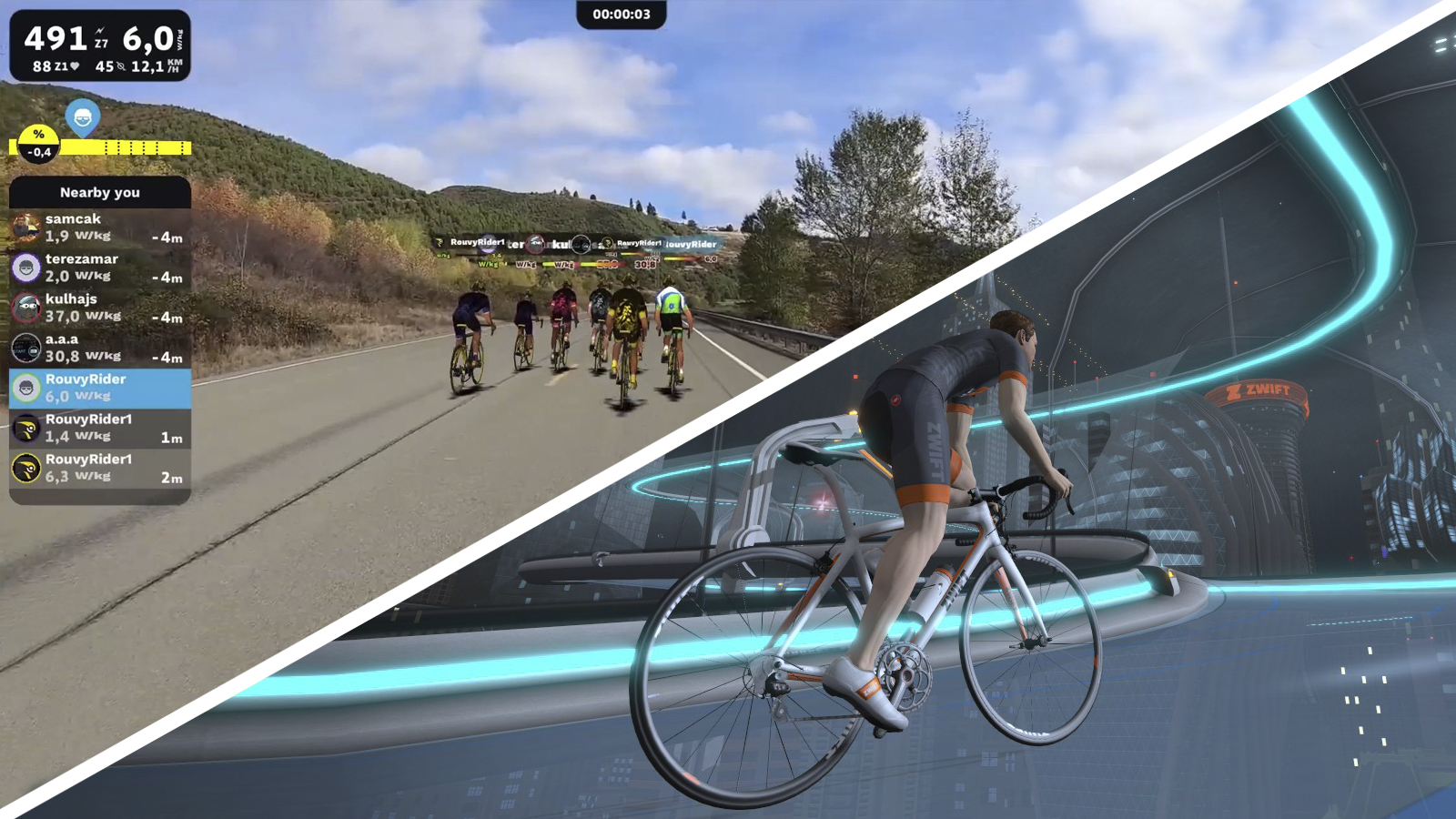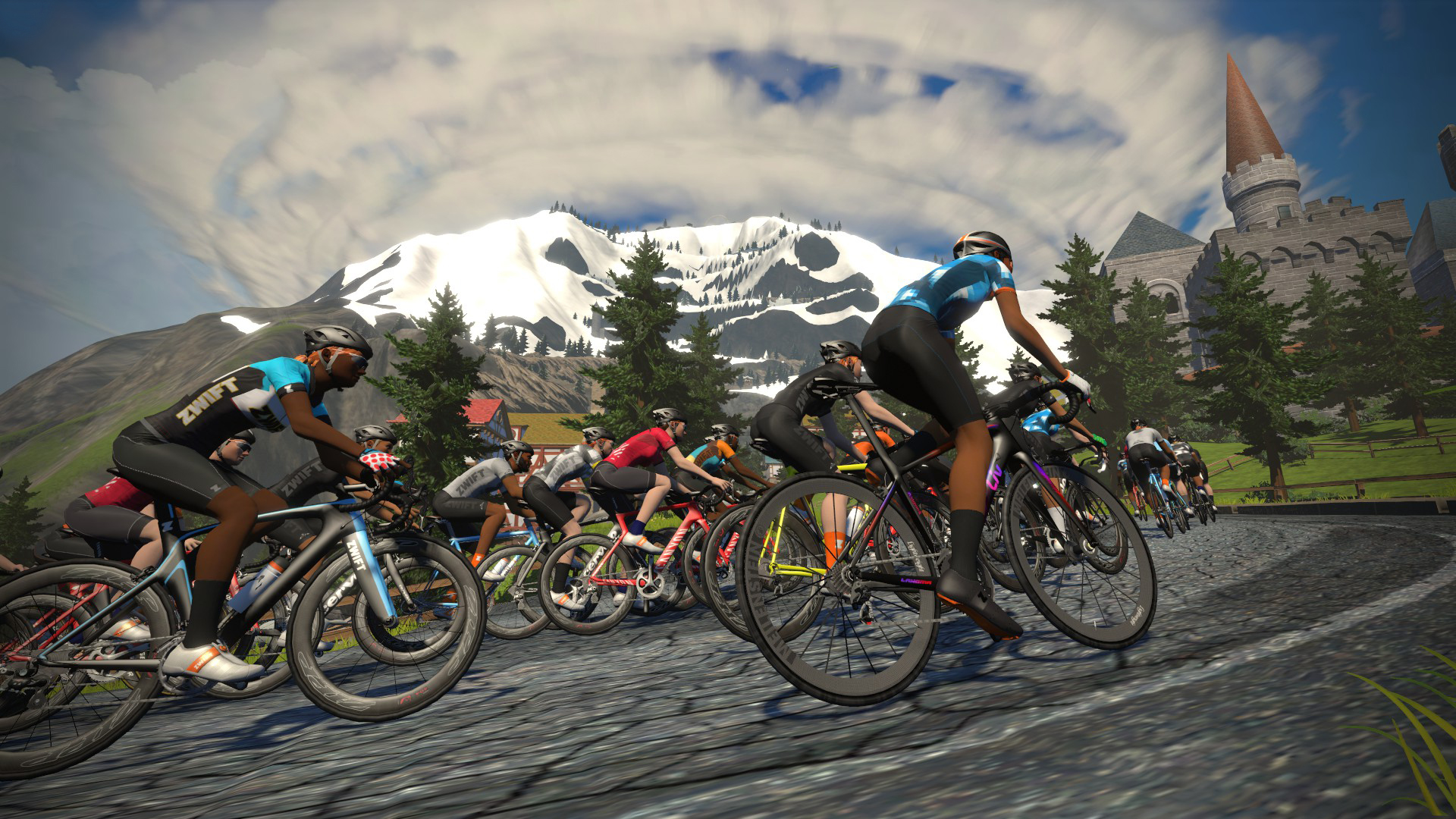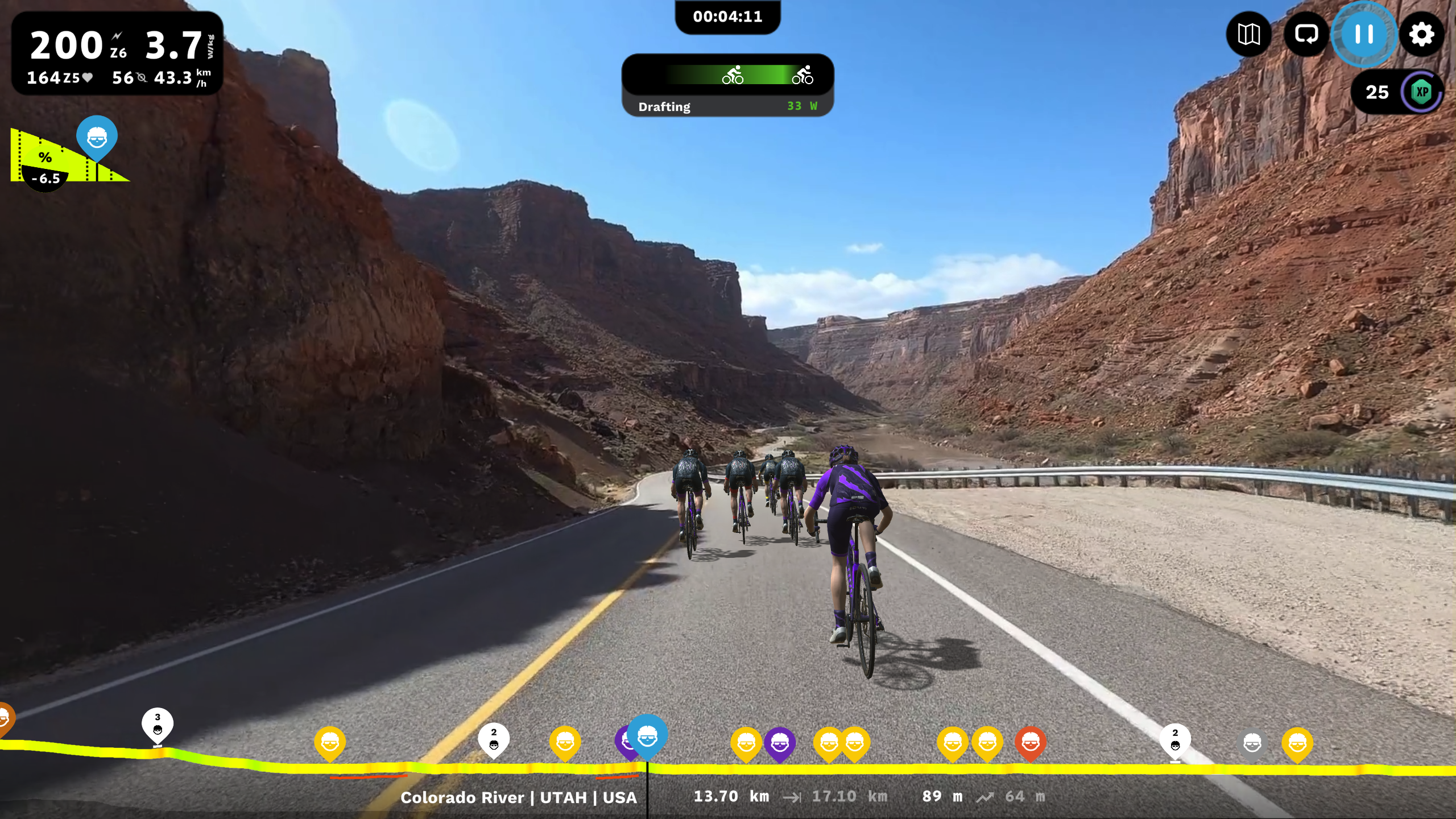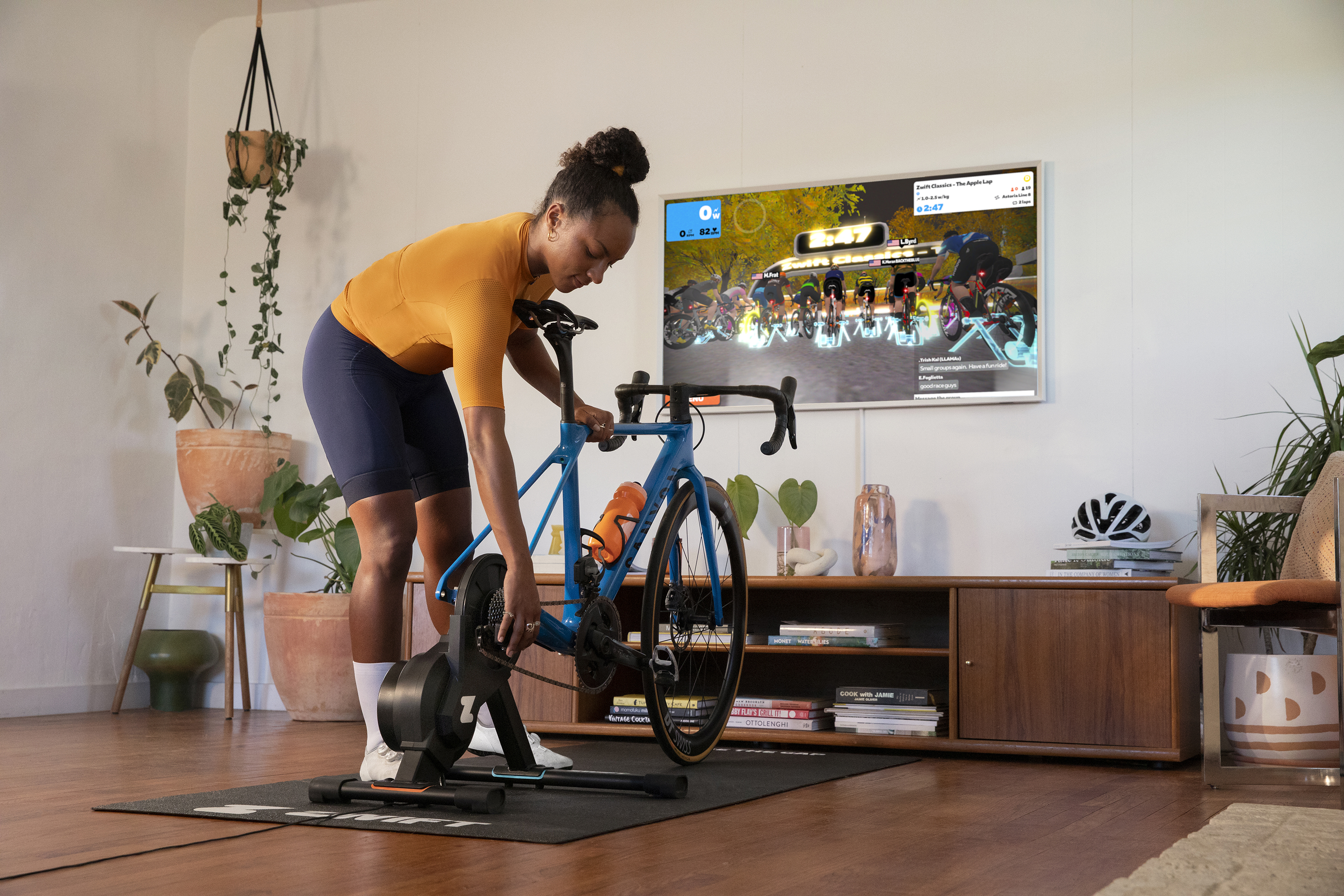Zwift vs Rouvy: Which is better?
We compare Zwift vs Rouvy - two indoor cycling apps that offer group rides, workouts and racing - to find out which is better

Zwift is a juggernaut. For casual cyclists, it's the only virtual training platform they've likely ever heard about. It's such a phenomenon that it has almost become the Hoover, or Kleenex, of indoor cycling.
Despite its huge status in the virtual riding space, it is not the only option. There are many other indoor cycling apps out there, each with its own strengths, weaknesses and set of dedicated followers. Some of the other big players include TrainerRoad, Wahoo X (formerly Systm/Sufferfest), BKool and Rouvy. Today we are going to take a look at Rouvy.
There are a lot of similarities in many of the virtual training platforms. They are all based on real-world cycling and they all use similar technology. That means whatever option you end up using, the connection to a computer will be similar and they will be compatible with the best smart trainers and the best exercise bikes.
In this article, we'll take a look at the similarities and differences between Zwift and Rouvy, and we will help you decide which option makes the most sense for you.
But first, to use either, you'll need some hardware, namely a turbo trainer. Our guides linked above will help you decide, but here are a few of our top picks.
- Wahoo Kickr (V6) review
- Elite Direto XR review
- Wahoo Kickr Core Zwift One review
- Elite Suito review
- Tacx Neo 3M review
- Tacx Flux S review

Zwift
To kick off, a Zwift subscription is $19.99 per month or $199.99 per year. Zwift offers a 14-day free trial and a 30-day money-back guarantee if you aren't happy.
Being the biggest has advantages. When your platform dominates the market, you become the default. In many ways, the biggest challenge becomes staying ahead of smaller, nimbler, competitors. That's where Zwift is now and they are definitely leveraging that huge user base. Above all else, when you log on to Zwift, you know there are always many other riders doing the same thing. You will never be alone. Given that large user base, there are three basic ways that Zwift differentiates itself: racing, group rides, and graphics.
Graphics is the easiest one to start with. Sometimes doing something better requires a different way of thinking. If you think of computer graphics as measured by photorealism then Zwift is the worst. That's not what Zwift is about though. While there are some courses that mimic the real world, Zwift has never tried to look like the real world. The basic premise is that of a virtual world and the graphics reflect that.
The latest race content, interviews, features, reviews and expert buying guides, direct to your inbox!
A better way to measure the success of graphics is how they work for the end user. From the very beginning, Zwift decided to think differently. They created a graphics style that works to get people riding, not to look like the real world. Measured in this way Zwift is a huge success and far ahead of the competition. The graphics don't look like the real world but they are smooth, clever and easy to understand, and they work on low-end hardware. It's a feature that might not get as much coverage but it's also one of the best parts of the Zwift story.
Turning our attention to racing and group rides, this is where the huge user base that Zwift enjoys becomes such an advantage. Any day and any time of day there is some opportunity to ride with (or against) other people. Whatever time zone you are in and no matter the day there are other people just like you logging in and riding together.
If you want to race, you have access to a range that starts from the first race you've ever done up to the WorldTour level. Zwift has become a force for those who have traditionally had less opportunity for representation in high-level racing. No matter who you are, from the comfort of your home you could work your way up the ranks, and race at the highest level. Or you could enjoy your first race without having to worry about crashing, scheduling or location.
If racing isn't your thing, there are plenty of other group-ride opportunities. You could do interval workouts with a group of people. You could do a cooperative ride where your group tries to keep away from a faster group by working together. Or you could join a traditional group ride with your closest friends. Cultivate a relationship through Facebook groups and Discord then enjoy a virtual ride with those same people.
- Zwift vs TrainerRoad: An indoor cycling head-to-head
- Zwift vs Wahoo Systm: Which indoor cycling app is right for you?

Rouvy
Rouvy costs less than Zwift, a subscription costs $14.99 per month. Rouvy also offers pair and group discounts.
In the same way that being the biggest player is an asset, it can also be a hindrance. Zwift has been around for over ten years and there are a lot of people who have done everything they want to. There are no more levels to reach, and no more items to unlock, and for some people, every route is old news, although Zwift does regularly add extra routes to its virtual worlds. This creates an opportunity for something different.
Even if you are just starting your virtual riding journey, Rouvy has found a way to set itself apart. This is in spite of having a similar focus to Zwift. While some virtual services are hyper-focused on training and workouts, both Zwift and Rouvy lean towards just riding your bike. They both offer workouts and racing but that's not the heart of the service. When considering Rouvy, consider the ways it does things differently to Zwift.
The biggest difference between Zwift and Rouvy is the place you are riding. While Zwift is a virtual world, Rouvy is the real world. Instead of entering the imagination of a programmer, you get to venture out into the real world. Will you take the opportunity to ride the places you've always wanted to ride but might not ever have a chance to? Or will you ride your old favourite routes when you can't otherwise do so?
Choose a famous location or race course, and you will likely have the best quality video. The highest resolution and the best footage exists because there is a lot of available footage in famous locations. There are other choices though. The library is extensive and even the lower quality video is high definition. Users can even upload their own videos, add virtual objects like banners and contribute to a huge library of options.
Even if there are no videos available, you can still use Rouvy to ride in a location. Utilising Rouvy Route Creator you can shoot videos and create new rides for the community. Alternatively, you can import GPS data or manually draw a route using Google Earth. If you don't have a video associated, the visual while you ride will be a marker on a map but the climbs and descents will still be accurate.
All these options for real-world riding make it possible to train for any event you can imagine. What better way to really understand a course than to ride it ahead of time? If you have a local race you want to take part in next year, download the GPX file from someone who has done it. Turn that data into a Rouvy route then ride it all winter long.
Rouvy does have races also. Rouvy has a leg up on Zwift races in an important way. While both platforms allow for racing pre-scheduled races, only Rouvy lets anyone make their own race. There's nothing quite so motivating as riding with other people. Schedule a ride on a particular route ahead of time then make it public. More often than not you will find other people on your course. It's a great way to stay engaged or a great way for anyone to create a virtual race.

Zwift vs Rouvy - Which do you choose?
There is no doubt that Zwift has a larger user base and more opportunities for riding with people. Even when you ride with people on Rouvy it is a much more isolated feeling. You can put the augmented reality features to use so that you have a better sense of where people are on a course but it's still not the same. When you are mixing it up in a lead pack on a Zwift race it feels like the real thing. You modulate your power and keep yourself sheltered in the pack knowing that there is a small climb coming. Then when the climb hits you explode off the front and empty the tank to see if you can make a gap happen.
Price-wise Rouvy is cheaper than Zwift and it allows you to pause your membership once a year for up to 180 days. If you do get the itch to ride indoors, you can buy individual days while keeping your membership paused. On Zwift, you're locked into paying your monthly or annual membership fee, even if you're not using the app.
- Cheapest Zwift setup: Where to find turbo trainers in stock, the best deals and a guide on how to get onto Zwift
At the same time, as good as the routes on Zwift are, they are inherently artificial. The real world has a randomness that Zwift routes never do. Even on flat rides, there are constant little undulations and when you compare the two, Rouvy always feels a little more realistic. Riding on Zwift, most of the routes feel like a lot of thought has gone into them. The gradients are consistent without random ups and downs that you find in the real world. The amount of time spent climbing hard before you get a short break can feel manufactured too. The routes are so well designed they end up lacking that little extra random quality the real world has.
If you are able to make it work then get both. There is some overlap but each has a place. When you want a community, Zwift has it. When you want real-world riding, Rouvy is better. Even with the enormous number of Zwift events you might end up not finding exactly what you want a lot of the time. At those times jump over to Rouvy and pick a place to ride you've never been. Just like in the real world, the people you ride with and the places you go are the things that get you through the hardest rides. Use a combination of both by using both platforms or pick which one you think is going to be best for your preferred type of riding.
Josh hails from the Pacific Northwest of the United States but would prefer riding through the desert than the rain. He will happily talk for hours about the minutiae of cycling tech but also has an understanding that most people just want things to work. He is a road cyclist at heart and doesn't care much if those roads are paved, dirt, or digital. Although he rarely races, if you ask him to ride from sunrise to sunset the answer will be yes. Height: 5'9" Weight: 140 lb. Rides: Salsa Warbird, Cannondale CAAD9, Enve Melee, Look 795 Blade RS, Priority Continuum Onyx
